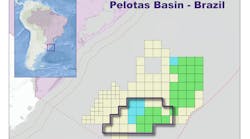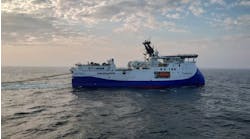New technique critical for Hickory Field, Gulf of Mexico
Prestack depth migration has proven to be a critical process in subsalt exploration of the Gulf of Mexico. This technology provides the geophysicist with a means of compensating for the strong seismic refraction effects that occur at salt/sediment interfaces due to rapid velocity changes, and to image the geologic section underlying a salt mass. Based on this technology, several subsalt discoveries have been drilled in the past decade. Few, if any, subsalt wells are now drilled without the benefits of depth imaging.
Since depth migration was first employed for subsalt imaging, there have been major advances in computing capabilities, especially the development of inexpensive higher speed chips, massively paralleled multinode clusters, and high-capacity data storage systems. As a result, it is now feasible to solve problems, which were previously considered intractable. These computing capabilities provide the ability to perform prestack depth migration (PreSDM) using wave equation algorithms in place of the previous ray-trace based Kirchhoff algorithms. This is leading to wave equation depth migration, the next innovation in depth imaging.
3D wave equation prestack depth migration image based on (A) 1/18, (B) 1/9, and (C) 1/6 of the recorded shots.
This case study of 3D wave equation depth migration in a subsalt setting is based on the Hickory Field in the Gulf of Mexico. The results demonstrate that the technique is now practical and cost effective, and illustrate the potential advantages that can be gained with wave equation depth migration.
Technique differences
While Kirchhoff PreSDM has been successful in imaging many subsalt prospects, limitations have been identified with this approach:
- Ray tracing simulation - Seismic wave propagation is simulated by ray tracing through an earth model of the subsurface. Ray tracing can have difficulty with true geologic complexity and requires a smoothed velocity/depth model for stable operation.
- For each image point, energy propagation is normally modeled only along a single path for a given source-receiver pair. Additional paths may be modeled, but at significant computation expense.
- Lack of amplitude preservation in zones of rapid velocity variation.
- Significant migration artifacts can occur, especially underlying large, non-planar, velocity contrasts.
In contrast, wave equation migration offers the following advantages:
- Seismic wave propagation through the earth is simulated directly by solving the wave equation.
- Wave phenomena such as scattering and wavefront expansion are treated explicitly.
- Multiple energy propagation paths from source to receiver are honored.
- Ray tracing is not required.
- Relative amplitude information is preserved.
The method used in this project is a shot-domain, finite-difference implementation of the 3D, one-way acoustic wave equation (Zhou et al, 2001). The technique involves downward continuation of the recorded wavefield for each shot. This is followed by the application of an illumination weighted imaging condition, which results in output of a 3D depth image volume for each shot. These are combined to generate the final subsurface image.
Imaging subsalt
Hickory Field is located in Grand Isle Blocks 110, 111, and 116 in the Gulf of Mexico, in 320 ft water depth. The Hickory structure is a deep-seated anticline flanked by two salt bodies and is located along the sediment fairway between two mini-basins. The two salt bodies coalesce above the field to form a large salt pinnacle that is over 9,300 ft thick. A number of prospective intervals are present in the subsalt section, the shallowest of which are truncated against the base of salt. Significant gas and condensate accumulations have been encountered in five subsalt zones ranging in depth from 14,750 ft measured depth (MD) down to 19,500 ft MD as well as in several thinner zones.
Data density
As the algorithm migrates each shot individually, it produces an image volume illuminating part of the subsurface. Each migrated shot adds linearly to the output image. This process allows the output image quality to be continually assessed as the migration proceeds, permitting the user to select the number of shots to migrate and so balance image quality against computational effort.
With 1/18 of the shots, i.e., approximately 5% of the recorded data, wave equation migration succeeded in imaging the salt body and the subsalt section. Incorporating additional shots in the migration improved the signal/noise ratio, up to a limit, but did not materially impact the image. An improvement in signal/noise was observed between images generated with 1/18 and 1/9 of the shots, but less improvement was seen in extending the input to 1/6 of the shots. Based on these comparisons it was determined that migration of 1/6 of the shots was sufficient for imaging this dataset.
As with Kirchhoff migration, the wave equation algorithm provides 3D depth migrated gathers. When migrated with the correct velocity field, primary reflection events should have a flat moveout on the migrated gathers. This provides a potent tool for creating and validating the migration velocity model, a critical aspect of depth imaging. Moreover wave equation migrated gathers offer the advantage that their amplitudes are determined using the wave equation.
Illumination section along profile shown on the prior page. Red indicates higher illuminations, blue indicates lower.
An illumination volume, a measure of the energy propagating downwards through the earth model, is also generated for each shot at no additional computational cost. This volume provides a powerful quality control and interpretation aid, which is not available with Kirchhoff migration.
The second figure shows good illumination in the subsalt section from the start of the line up to Xline 8420, corresponding to an image area of coherent and continuous seismic reflections with good signal/noise ratio. However, it also shows an area of poorer illumination in the subsalt section from Xline 8420 to 8650.
This correlates with an area of low seismic signal strength in the first figure, which thus can be attributed to low illumination due to the geometry of the overlying salt body. This demonstrates the strength of this tool in assessing imaging results. When used in conjunction with the 3D depth volume, the illumination volume allows the interpreter to assess whether reflectivity variations in the depth volume are a result of geologic variation or are associated with illumination variability.
Wave equation vs. Kirchhoff
The velocity models for the two migrations are similar, although not identical. Several points of interest are noted in this comparison:
- The Kirchhoff migration shows spurious energy within the salt body, a common artifact of Kirchhoff migration that is not seen on the wave equation migration.
- Kirchhoff migration displays a dipping noise pattern in the subsalt section, crosscutting the primary reflections. This noise is not present on the wave equation migration, which shows better continuity of subsalt reflections and improved image quality.
- Of particular interest is the high quality of the image of the subsalt reflections truncating against the Base of Salt on the wave equation migration, clearly superior to the Kirchhoff result.
- The image of the base of salt is variable across the survey. Along this profile wave equation migration yields a crisper but less continuous image than Kirchhoff migration.
The final figure shows depth slices of wave equation and Kirchhoff migrations, slicing through the salt body at a depth of 15,750 ft. The wave equation migration shows very crisp definition of the salt body, superior to that of Kirchhoff migration.
Conclusions
Wave equation PreSDM is a viable and cost-effective subsalt imaging technique that provides considerable advantages over Kirchhoff migration. Wave equation migration directly simulates wave propagation through the earth; it avoids many of the artifacts associated with Kirchhoff migration; and it preserves relative amplitude information.
Comparison of (A) wave equation and (B) Kirchhoff 3D prestack depth migrations.
As this is a shot-based approach, the user has the capability to select the input shot density, balancing image quality against computational effort.
Wave equation migration also provides an illumination volume, a new and effective diagnostic tool for evaluating imaging results. This is computed as part of the migration process, at no additional computational cost.
In the case study shown, wave equation migration provided superior subsalt imaging compared to Kirchhoff depth migration. This is demonstrated strongly by the suppression of crosscutting noise that was seen on the Kirchhoff migration and the clear imaging of events truncated by the base of salt.
Acknowledgements
We thank Anadarko Petroleum Corporation for permission to present this work and NuTec Energy Services where the wave equation migration was performed. The seismic data shown are from the Diamond Geophysical/PGS, Grand Isle Phase I 3D survey.
Reference
Zhou, Z.Z., and Stein, J.A., 2001, Practical, accurate, full-azimuth 3D prestack finite difference depth migration, 71th Ann. Intl. Mtg., Soc. Expl. Geophys., Expanded Abstracts.







